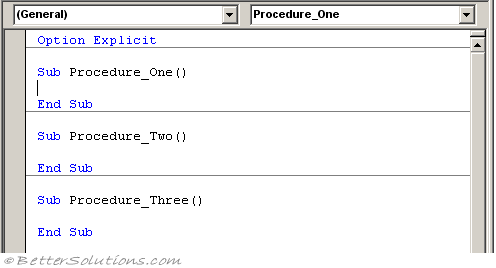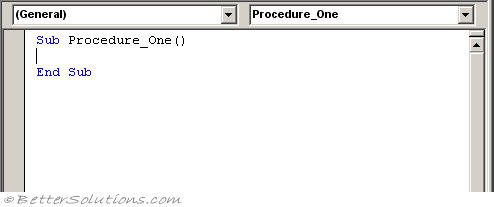How To Open The Code Window
Code Window
This displays the lawmaking associated with the particular selected in the Project Explorer window.
Also sometimes referred to as a Module window.

You can even just double click the detail in the Project Explorer window.
Displaying the Code Window
To brandish the code select the item in the Project Explorer window and either choose (View > Lawmaking) or you lot can alternatively use the shortcut key (F7).
A lawmaking module volition normally contain more than one procedure or function.
The IDE offers y'all a choice of whether to display the procedures one at a time (process view) or all at one (total module view).
You can alter the views past clicking on the pocket-sized buttons in the lower-left corner of the code window. Full Module view is the default.
You can minimise, maximise, hide and rearrange your code windows.
Employ the Code window to write, display, and edit Visual Bones code.
You can open every bit many Code windows as you take modules, so you tin can easily view the lawmaking in dissimilar forms or modules, and re-create and paste between them.
Yous can open a Code window from:
The Project window, by selecting a form or module, and choosing the View Code push.
A UserForm window, by double-clicking a control or course, choosing Lawmaking from the View carte du jour, or pressing F7.
The Recycle Bin.
Window Elements
Object Box
Displays the name of the selected object. Click the pointer to the right of the listing box to brandish a list of all objects associated with the form.
Procedures/Events Box
Lists all the events recognized past Visual Basic for a class or control displayed in the Object box. When you lot select an event, the event procedure associated with that event proper name is displayed in the Code window.
If (General) is displayed in the Object box, the Procedure box lists whatsoever declarations and all of the general procedures that have been created for the form. If you are editing module code, the Procedure box lists all of the full general procedures in the module. In either case, the procedure you select in the Process box is displayed in the Code window.
All the procedures in a module appear in a single, scrollable list that is sorted alphabetically past name. Selecting a procedure using the driblet down list boxes at the elevation of the Code window moves the cursor to the first line of code in the procedure you select.
Macros can as well exist created by typing the commands directly into a code window.
This is often faster than using the macro recorder bold yous are familiar with the corresponding object model.
Lawmaking windows can hold four different types of code
1) Subroutines - a gear up of instructions that performs a particular job
2) Functions - a set up of instructions that performs a particular task and then returns a value or an array.
3) Properties - these are used in grade modules
4) Declarations - this is used to declare variables that can be used and referenced from anywhere in the module (or projection).
A single VBA module can store whatsoever number of whatsoever of the in a higher place and how these are organised is up to you.
Full Module View
icon - Full Module View Icon - Displays the unabridged code in the module.
This is the default.

horizontal lines separating the procedures and functions.
Process View
This can be controlled from (Tools > Options)(Editor Tab, "Default to Full Module View")
icon - Process View Icon - Displays the selected procedure. Simply ane procedure at a fourth dimension is displayed in the Code window.

There are multiple levels of Undo and Redo so don't worry if y'all e'er remove the wrong teaching or procedure. You can click the Undo button (Ctrl + "Z") repeatedly.
Subsequently undoing, you lot tin can press F4 to redo changes that were previously undone.
Force Intellisense
When no listbox is displayed y'all can printing (Ctrl + Spacebar) to consummate the input with the given keyword (or variable proper noun).
If there is more than one option then the listbox automatically appears.
In one case the listbox has been displayed y'all can select the desired input with the cursor key
The Tab key completes the choice.
With ESC you tin avert having to select from the listbox and tin can complete the input manually.
© 2022 Better Solutions Express. All Rights Reserved. © 2022 Better Solutions Express Top PrevNext
Source: https://bettersolutions.com/vba/visual-basic-editor/code-window.htm
Posted by: wynneagre1952.blogspot.com

0 Response to "How To Open The Code Window"
Post a Comment